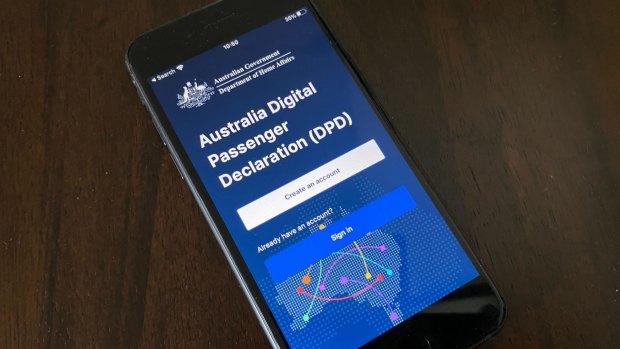This was published 1 year ago
Digital Passenger Declaration (DPD) app scrapped and good riddance
By Ben Groundwater

Many travellers had problems using the Digital Passenger Declaration app.Credit: Craig Platt
The DPD is dead. Long live the DPD?
I don't think so. I can't believe many Australian travellers would be mourning the loss of the Australian Digital Passenger Declaration, the government app that was introduced in February this year as a requirement for travellers arriving in this fair country, and will be discontinued from Wednesday this week.
Everyone was so excited about international borders reopening back in February that we paid scant attention to this new piece of technology, this data gathering device that we would have to interact with every time we attempted to get back into Australia (because one of the baffling quirks of the DPD was that it didn't remember any of your details, and so you would have to re-enter everything every time you travelled).
I wanted to like the DPD, I really did. After all, it was representative of freedom, of the ability to once more move around the world at leisure. It also made sense in a lot of ways, given Australia is one of the few developed countries in the world still using paper arrivals cards, and a shift to online seemed a good idea.
You can imagine my surprise then, first time I entered Australia after going through the laborious DPD process online, only to find that I still had to enter all of those same details once again on the old paper arrivals cards (my assumption is those cards were needed purely for the customs declaration on one side – still, you had to fill the whole thing in: intended address, next of kin, reason for visiting, etcetera etcetera.)
So, what was the good of the DPD? Though the Department of Home Affairs swore there were never any problems with the app, which was introduced in February this year and cost $75 million to develop – you read that right, $75 million for about five months of service – anyone who went anywhere near it would have been able to tell you it was littered with bugs (the app currently has a rating of 1.3 stars on Apple's AppStore, from more than 1200 reviews). Traveller's readers were equally scathing.
To begin with, obviously, was the fact you had to start from scratch every time you travelled, re-entering your every detail, even including your username and password, which couldn't be saved. So that's time-consuming in itself.
But then there were all the other bugs, some of which eventually seemed to be worked out, some of which didn't.
You would have to use your phone to scan the RFID chip in your passport, which sometimes worked, sometimes didn't. You would have to scan the QR code on your vaccination certificate, which was an exercise in extreme patience, particularly if that piece of paper had the tiniest crease in it, which, given you had just been travelling around the world with it, of course it did. You would have to scan the QR code on your PCR or RAT, too, when that was necessary, which again was clunky and annoying.
And you would do all of this while overseas (it couldn't be done in advance), at the mercy of whatever dodgy hotel Wi-Fi signal you managed to access. Then, of course, you would discover you had to show your vaccination certificate and PCR test or RAT once again to people at the airport to check in for your flight (the completed DPD apparently not being enough evidence), and you would then have to fill out all of those details – once again – on that yellow arrivals card.
I only left the country a few times and already it was driving me crazy; frequent business travellers must have lost the plot entirely.
On Sunday, however, the new federal government announced an end to the requirement to use the DPD, as well as an end this week to the COVID-19 vaccination mandate that applied to all arrivals into Australia. It's the sort of policy that would probably have caused certain heads to explode had it been enacted by the previous government, but now seems wise, particularly given the almost universal worldwide moves to loosen COVID-19-related restrictions on travellers.
Those few anti-vax hold-outs here can now travel the world and return home to Australia. All of us can do so without having to tangle with a buggy app that forces you to do the same things over and over again.
Though, don't get too excited. The long-term plan, according to Home Affairs minister Clare O'Neil, is to reintroduce the DPD as a permanent replacement for those arrival cards.
"While in time it will replace the paper-based incoming passenger card," O'Neil said on Sunday, "it needs a lot more work to make it user-friendly."
That's something every traveller can surely agree on.
See also: The countries still making it hard (or impossible) for Australians to visit
Sign up for the Traveller newsletter
The latest travel news, tips and inspiration delivered to your inbox. Sign up now.